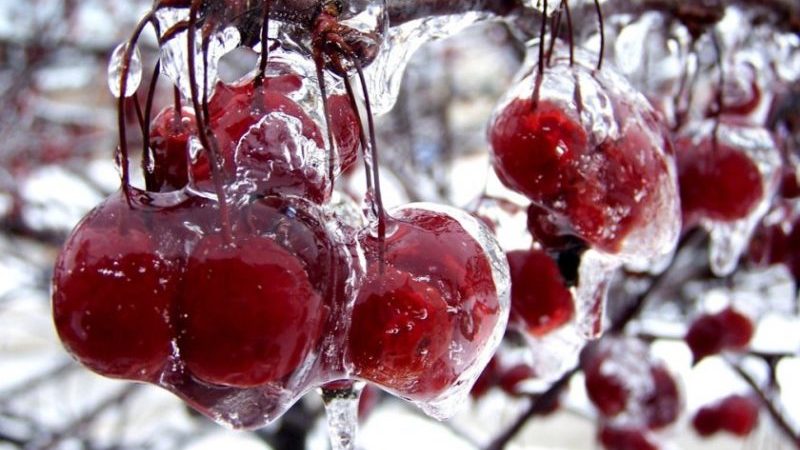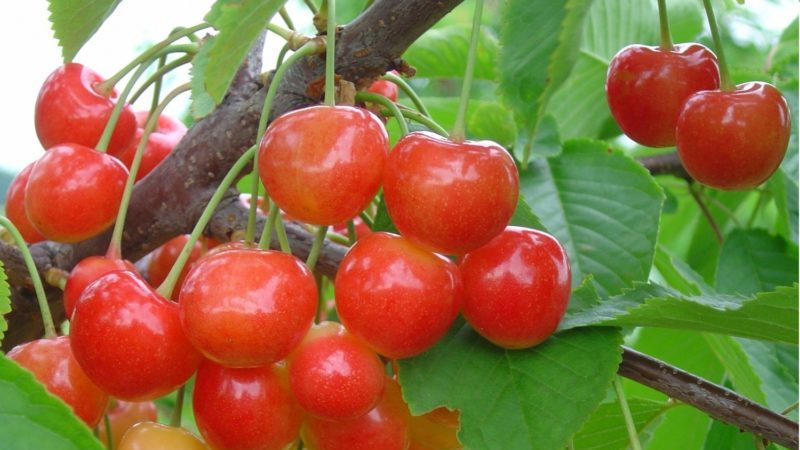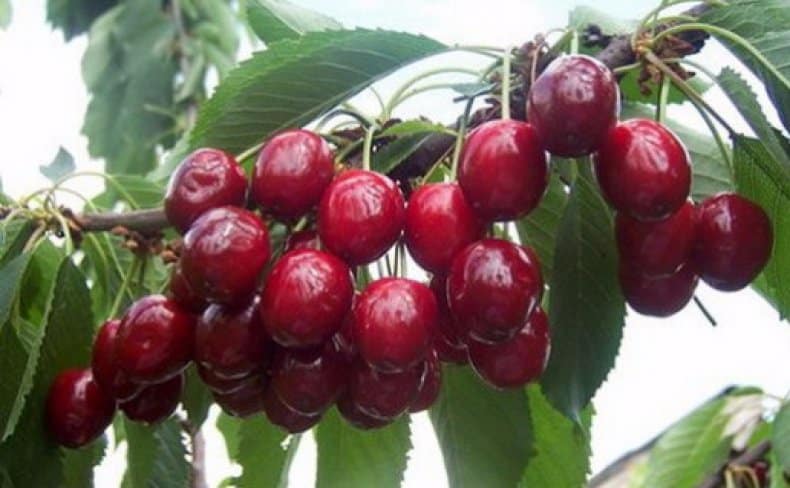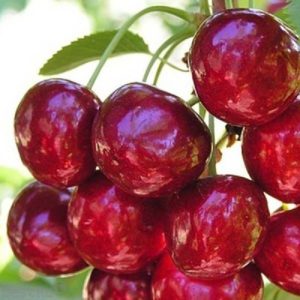Review of the best winter-hardy cherry varieties and criteria for their selection
It is quite possible to grow cherries and get a rich harvest in the Moscow region, Siberia or the Urals. If you choose the right variety and take into account the timing of flowering, the tree will withstand a frosty winter and maintain productivity. Let's consider the features of the best winter-hardy plants and study the rules of their agricultural technology.
Requirements for winter-hardy cherry varieties
Sweet cherries love good watering, but do not tolerate excess moisture and drowning of the roots. Its flower buds are capricious to temperature fluctuations. The forks of the skeletal branches and the lower bark are sensitive to frost.
Breeders took into account the nature of the crop and developed winter-hardy varieties with good yields. The fruits retained their high quality, and the trees became more resistant to diseases. The work was carried out in regions with different climates, so each plant has its own characteristics.

General requirements for winter-hardy cherries:
- resistance to the maximum permissible frost for the variety;
- maintaining frost resistance during thaw;
- winter hardiness of flower buds during return frosts;
- the ability of the bark to quickly recover after freezing;
- resistance to drought and moisture;
- unpretentiousness in development conditions;
- immunity to major diseases.
Also take into account:
- terms of survival and fruiting;
- productivity;
- practicality of collection and transportation.
The best winter-hardy varieties
The ideal characteristic of a variety for harsh climatic conditions would be a combination of winter hardiness of the tree and frost resistance of fruit buds. Equally important are the taste of the berries, the timing of their ripening and the amount of harvest.
Based on the time of flowering and fruit ripening, plants are divided into 3 groups:
- Early (Fatezh, Italianka, Sadko, Gronkavaya). The harvest is harvested in late June - early July.
- Mid-season (Rechitsa, Zyubarova, Adelina). Ripening in the 2nd decade of July.
- Late (Bryansk pink, Veda, Tyutchevka). The berries will ripen in the 3rd decade of July.
Rechitsa
A variety with an average ripening period of berries, self-sterile, with high winter hardiness of buds and wood. Actively recovering after severe freezing. Frost resistance - down to -30°C. Weak tolerance to drought.
The tree develops quickly and grows up to 3 m. The crown is pyramidal in shape and not very dense. The plant is resistant to fungal diseases. From 5 years landings begins to bear fruit.
The fruits are a rich burgundy color with a sweet taste and dense pulp, weighing 5-6 g each. The berries are easily separated from the stalk and do not crack due to rain. After ripening, they do not fall off for 10 days and are universal in use.
Productivity - 30 kg. The fruits can withstand long-term transportation.
Italian
The variety is self-sterile and belongs to the early ripening variety. The winter-hardy qualities of the tree are higher than those of fruit buds. The culture is undemanding to development conditions and is resistant to drought. Frost resistance reaches -28°C.
The culture grows about 4 m in height. The crown is lush and pyramidal. With an average rate of growth and development, good resistance to coccomycosis.
Fruiting begins at 4 years of age. The berries are large burgundy, weigh about 8 g. The pulp is elastic, not too dense, and easily separates from the seed.The taste is pleasantly sweet. The fruits do not crack due to rain and are universal in use.
Productivity - up to 80 kg per mature tree, taking into account adverse weather conditions. Excellent taste, uniform fruiting, high yield and resistance to transportation make Italiana suitable for cultivation on an industrial scale.
Fatezh
Self-sterile early ripening variety. The winter hardiness of flower buds is lower than that of the tree. Tolerates drought well, but is sensitive to waterlogging. Strong recovery ability after freezing. The plant can withstand temperatures ranging from -27...-35°C.
Cherry trees grow up to 5 m in height. The crown is spherical, drooping and of medium density. The culture does not suffer from coccomycosis and moniliosis. Fruits from 4 years old.
Reference! Fatezh is adapted to weather vagaries. Rain and drought do not affect yields.
Bright orange fruits with yellow barrels weigh from 4 to 6 g. The sweet taste is diluted with a refreshing sourness. The juicy pink flesh has a cartilaginous structure and is cleanly separated from the stone.
The yield from a ten-year-old tree is from 30 to 50 kg. Strong berries are not afraid of long transportation.
Veda
The culture is self-fertile and late-ripening. The tolerance to temperature changes is equally high in trees and flower buds. Average tolerance to prolonged drought. Minimum freezing of fruit buds. Does not like darkening, is undemanding to the soil composition. Withstands temperatures down to -30°C.
Cherry with active development and a dome-shaped thickened crown. Grows no more than 2.5 m in height. It begins to bear fruit by the 4th year of life and is resistant to coccomycosis.
The fruits are heart-shaped, dark scarlet, weighing up to 5 g. Tender to the touch and with juicy pulp.The pronounced sweet taste is complemented by a slight sourness. The berries do not crack, but quickly fall off after ripening.
Productivity - from 23 to 66 kg. The fruits can withstand transportation.
Zyubarova
The variety is self-sterile with an average fruit ripening period. The winter hardiness of the buds is lower than that of the tree. Withstands drought and sunburn. Undemanding to soils and development conditions, long-lived. Frost resistance - up to -30°C.
The tree is fast growing and powerful. Without constant pruning, it grows up to 20 m. The crown is wide, pyramidal and sparse. Strong branches can withstand the weight of snow cover, which protects the plant from freezing. Fruits in 4 years. Not affected by monilial burns and coccomycosis.
The fruits are spherical, weighing up to 10 g, smoky red in color. The juicy pulp has medium density. The berries are sweet with an unusual flavor.
The harvest is stable under any conditions: on average 30 kg per tree. Does not deteriorate during long-term transportation.
Bryansk pink

Self-sterile late-ripening variety. Flower buds are of average resistance to return frosts. The standard is not subject to frost damage and sunburn. This frost-resistant cherry can withstand temperatures down to -31°C.
A tree with a strong, wide-pyramidal crown that is raised. It is characterized by moderate growth and a maximum height of 2-3 m. It bears fruit in the 5th year of life. Highly resistant to moniliosis, coccomycosis and clasterosporiosis.
The fruits are round pink, weigh 4-5 g. The dense structure of the yellow pulp and piquant bitterness against the background of a sweet taste. The berries do not crack from moisture.
Productivity - from 20 to 30 kg per tree. The fruits are resistant to transportation.
Sadko
Early self-sterile variety. Tree and flower buds have different winter hardiness, but excellent tolerance to spring frosts and waterlogging of the soil. Withstands temperatures down to -30°C.
Cherry tree with a medium dense crown, which has a wide rounded shape. Grows up to 4 m. Fruits in 4 years. Immunity to moniliosis and clasterosporiasis. Less resistance to coccomycosis.
Large oval berries weighing up to 8 g, deep red. The sweet taste of the dense pulp is offset by an unobtrusive sourness. The fruits do not crack, are easily separated from the stalk, and are intended for table use.
The harvest ripens at the same time, up to 30 kg is collected from an adult tree.
This is interesting:
What cherry tree care should include in the fall: guidance from experienced gardeners.
How to properly plant cherries in the fall.
What are good hybrids of cherries and sweet cherries and what are their features.
Adeline
The plant is self-sterile, mid-season. The tree has high winter hardiness, with average winter hardiness in the flower buds. It is moisture-loving and can withstand frosts down to -25°C.
A tree with a raised crown of medium density and pyramidal shape. The maximum height is 3.5 m. It begins to bear fruit from the age of 4 years. It has average resistance to pests and fungal diseases.
Important! The harvest is harvested without tearing off the stalk.
The fruits are burgundy, heart-shaped, weighing 5–7 g. Cartilaginous, juicy pulp of medium density with a bright sweet taste. The variety is classified as a table variety.
Productivity - from 15 to 25 kg per adult plant. The berries do not tolerate transportation well.

Tyutchevka
The variety is late-ripening, self-sterile, with a good combination of winter hardiness of the tree and flower buds. Excellent ability for rapid regeneration. Frost resistance - down to -35°C.
The tree has a spherical, sparse, semi-spreading crown, height up to 4 m. It bears fruit from the age of 5.With high resistance to moniliosis, average resistance to coccomycosis and klyasterosporiosis.
The fruits are wide-round with an excellent sweet taste, weigh up to 7.5 g. The pulp is dense, juicy, aromatic. The berries partially crack due to waterlogging.
Reference! The taste characteristics of Tyutchevka fruits received the highest rating from tasters (4.9 points).
The harvest reaches up to 40 kg from an adult tree and is resistant to long-term transportation.
Gronkavaya

The variety is self-sterile and early ripening. Flower buds and tree have good resistance to spring return frosts. The culture is moisture-loving and can withstand frosts down to -27°C.
Cherries grow and develop quickly. The crown is wide and of medium density. The maximum height is 4.5 m. There is immunity to coccomycosis and monilial burns. The plant bears fruit for 4 years.
The berries are heart-shaped, dark red, weighing 6 g. The taste is juicy and sweet. Productivity is from 20 to 40 kg per mature tree. Good transportability.
Which variety to choose
Self-fertile (self-pollinating) trees do not require cross-pollination, but from all flowers they form at most 50% of berries. For this reason, self-fertility is not the main criterion for selection. To increase yields, pollinating varieties will be needed.
Attention! When planting cherries in pairs, keep in mind that the flowering dates of the trees must coincide.
The taste characteristics of the berries play a big role. Tyutchevka has the most delicious fruits. Sweet large-fruited plants - Sadko, Zyubarova, Italian. Gronkavaya, Veda and Fatezh are distinguished by berries with a sweet and sour taste.
At the dacha, it is more practical to plant low-growing trees from which it is convenient to harvest. The local climate and the variety’s immunity to major diseases are taken into account.For industrial gardens, important factors are yield, taste, appearance and transportability of berries.
Depending on the region
The Urals and Siberia have a harsh climate, so the yield will in any case be lower than at central latitudes. Nevertheless, winter-hardy cherries are successfully grown here. Varieties are selected according to their adaptation to the regions.

Suitable for the Urals:
- Bryansk pink;
- Fatezh;
- Tyutchevka;
- Rechitsa.
For Siberia:
- Zyubarova;
- Sadko;
- Bryansk pink;
- Veda.
For the capricious climate near Moscow:
- Italian;
- Gronkavaya;
- Fatezh;
- Adeline.
Late crops are more suitable for the northern regions, and early ripening ones are more suitable for the central regions.
Reviews
There are many good reviews about winter-hardy cherries. Most gardeners believe that failures during cultivation occur only due to the inexperience of gardeners and the purchase of low-quality seedlings:
Svetlana, Moscow region: “Our neighbors near Ramenskoye grow Tyutchevka cherries. The berries appeared quite recently, but are large and extremely tasty. We decided to plant the same tree for ourselves. We recently received our first harvest - this rich cherry taste cannot be confused with anything else.”
Sergey, Berdsk: “I ordered seedlings on the Internet. It took me a long time to choose the varieties. Fatezh and Veda were recommended to me. We have a cold climate, and I was worried that the plants would not survive the first winter. However, everything worked out well: the shoots began to actively grow.”
Conclusion
Winter hardiness of cherries is a property inherent only in some varieties. Good care for growing will not be enough. In order for the culture to take root, plants that are zoned to the area are selected. For early ripening, it is important that the flower buds withstand returning frosts.
The Urals and Siberia are suitable for trees with high frost resistance, and the middle latitudes are suitable for trees that are undemanding to weather changes. First, varieties are selected for the climate and among them are those with the most delicious fruits.